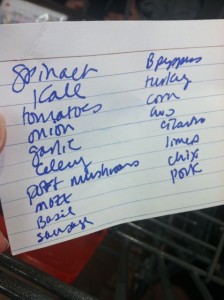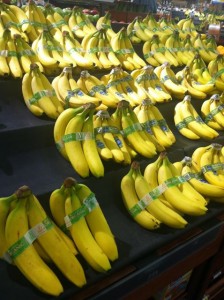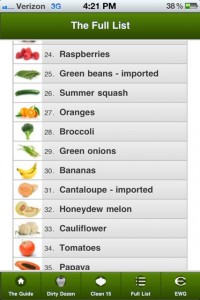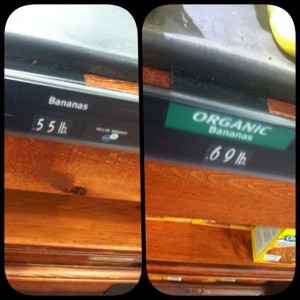**This post is part of the Get Real series. Please remember that this is meant as a learning community. We know that many of you are passionate about what you do and we want you to express that, just please do so in a way that will be an encouragement and aid to others making a transition. We want this to be a “safe space” for participants to learn. For that reason, we reserve the right to delete any comments that are not handled in this manner.
One of the hardest parts of making the transition to more real foods is navigating through the produce section of the grocery store. Organic options are growing and becoming more available. In a perfect world, we would all be able to afford organic produce. But the bottom line is really what are the best options for us to buy organic and the best to buy conventionally? I want to share with you my shopping trip from today to show you that it doesn’t have to be all or nothing, and you can find great tools to get what you want and still provide some savings.
First I made a list before I headed out. I am really trying not to go to the store without a list these days, so this is what my list looks like when I make it 30 minutes before I leave.

My chicken scratch list. Written one handed with a squirmy baby in the other.
I didn’t have time to really go through my list and see what I should get organic and not, so I broke out my phone and opened up the Dirty Dozen app, and set it next to my list. One thing not on the list was bananas. My husband called me as I was walking into the store and asked me to get them. I told him he was breaking his own rule for me by getting something not on my list as I walk in, but that’s a post for another day. And there they were:

Organic bananas ripe for the taking
That little green label around the bananas says ORGANIC. They look the same as the conventional bananas, but do I need to buy them? What’s the price difference?
Then I consulted my Dirty Dozen app and looked at the full list. 
Yes you read that right, it’s a $0.30 difference for organic celery. But being the second on the list for pesticide impact, I’ll gladly pay it. After all, I saved $0.14 on the bananas so it’s a wash right? Here’s what I bought today:
My loot, some organic, some conventional
I saved approximately $25 by using my Dirty Dozen guide and my store savings card just with this produce alone. The items in the picture above are arranged from least to most dirty from left to right. The guide is a helpful tool for those who can’t afford to go 100% organic all the time. It also helps to understand what processes our foods really take to get to the grocery store. The Environmental Working Group is a non-profit organization that advocates for and protects public health and the environment. They created the wonderful shopper’s guide by testing all the common vegetables and fruits for the number of pesticides in them.
Pesticides have been linked to cancer, hormone disruption, brain and nervous system toxicity, skin, eye, and lung irritation. There have also been recent studies linking pesticides to disorders in children like ADD and ADHD. I want to say right away that just because produce is organic does not mean that it is pesticide-free. It means that pesticides if used, “must be derived from natural sources, not synthetically manufactured. Also, these pesticides must be applied using equipment that has not been used to apply any synthetic materials for the past three years, and the land being planted cannot have been treated with synthetic materials for that period either.”
Having an organic certification is costly and quite the process as you can see, but just because your local farm isn’t organically certified, doesn’t mean they are not in process or use these practices already. Just ask the questions! Get to know your farmer. Is organic produce better than conventional produce? Research is ongoing, but there are recent studies that show that due to farming practices and soil types, that organic produce does contain higher nutritional values than conventional produce.
Start here and download the free short guide to take with you on your next trip to the store. Make a game plan to buy what you can organic. If you have a smartphone, there are some great apps out there to help you out as well.
- Dirty Dozen: Has the Dirty Dozen and Clean Fifteen list at your fingertips on your phone.
- What’s on My Food?: Goes even further than the EWG list and helps you see the pesticide loads in many foods.
- Locavore: Helps you to find local and in-season food in your areas.
- Honest Label: Helps you to really understand the labels. Whether there are GMO’s or not, and best yet, helps you to flag items that you are trying to avoid and it will tell you right away!
- Fooducate: Similar to Honest Label but has a bigger database.
April Week One Action Item:
- Print out the dirty dozen and clean 15 sheet and put them in your wallet or taped to your coupon binder. Or download the app it’s FREE! Make a point to pull it out when you shop this week and let us know what challenges you have and what you’ve learned from seeing this list.
April Get Real:
Please take a moment to thank our guest authors by clicking over to their sites and/or liking them on Facebook and/or Twitter.

